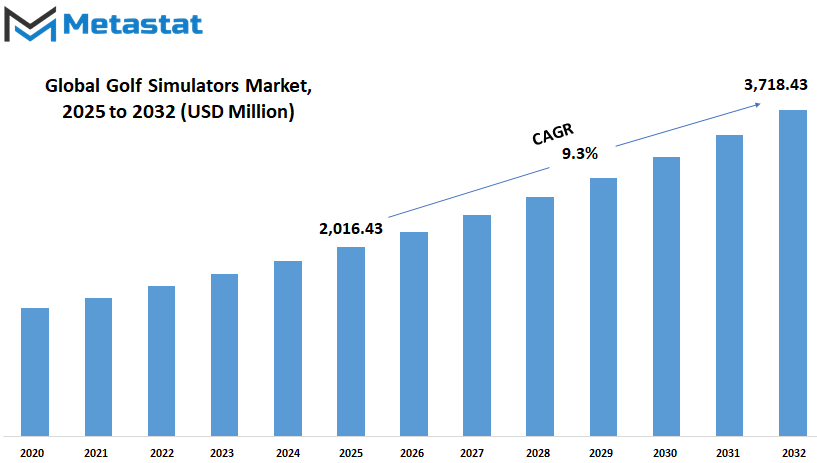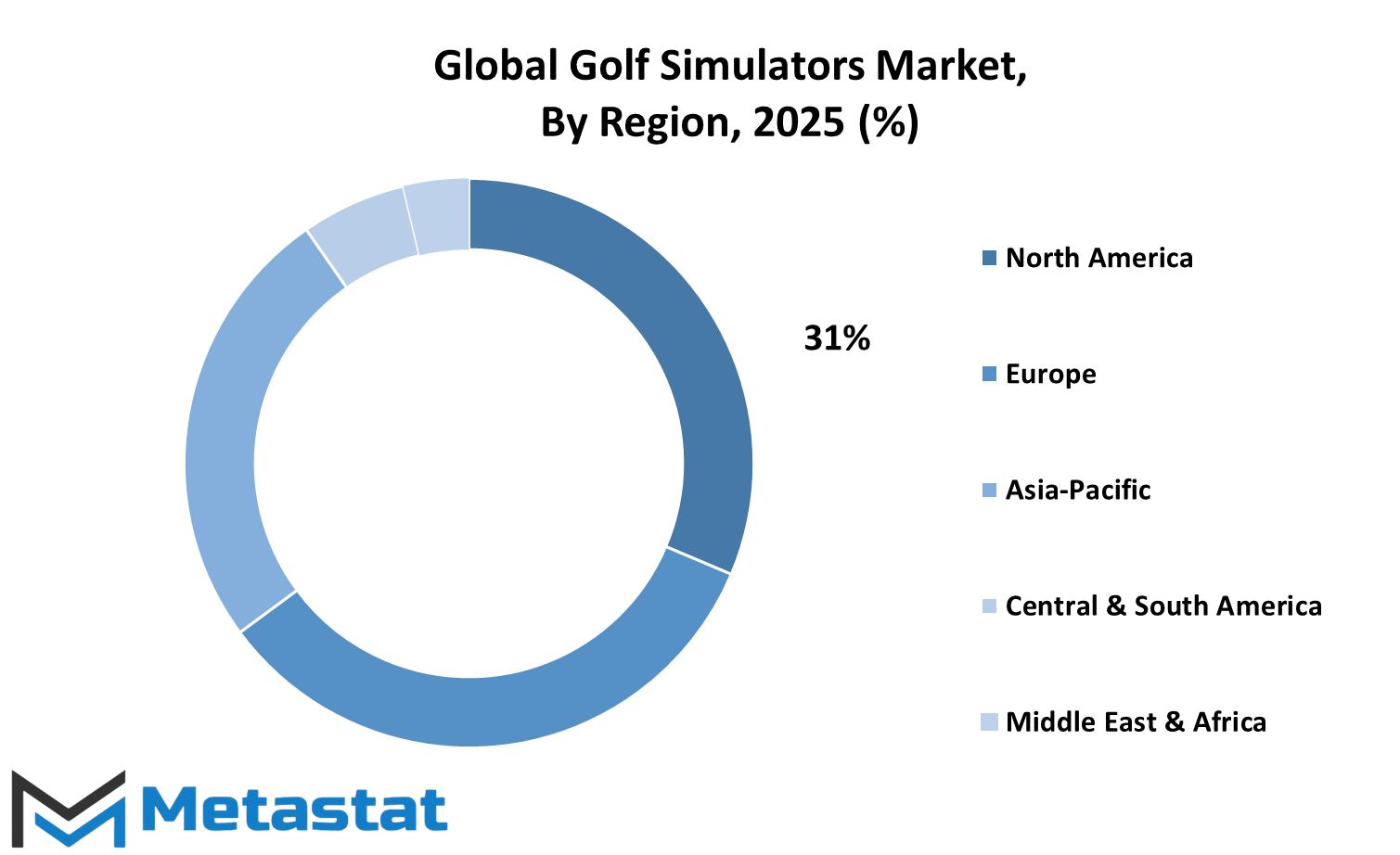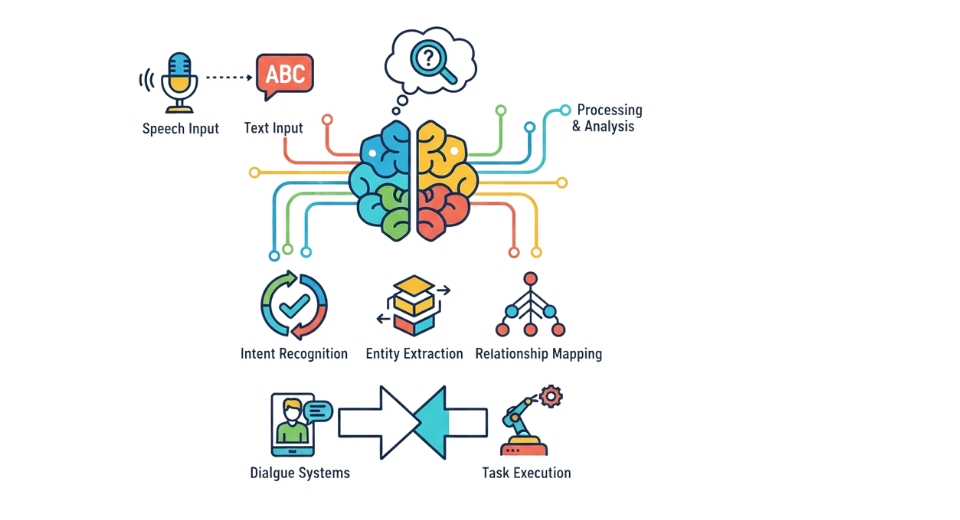MARKET OVERVIEW
The global golf simulators market and market will shape the way golf is made accessible, trained, and entertained by harnessing digital technology to provide realistic experiences within virtual spaces. The market will target the creation and deployment of simulation systems that mirror golf play through motion tracking, swing analysis, 3D course modeling, and sophisticated ball flight data. These systems will not only offer engrossing play but also serve as technical instruments for players to optimize performance under tightly controlled environments. The need for increased golf interaction in both private and public spaces will influence how the global golf simulators market increases its presence.
At homes, private residences, high-net-worth individuals and golfing fanatics will set up compact but technologically advanced systems that allow them to practice all year round without stepping out of the house. In commercial environments, including sports bars, country clubs, and event centers, multi-bay simulators will provide a combination of sport and entertainment in which users can play virtual rounds on familiar courses while socializing or as part of competitive leagues. The design of simulator solutions will comprise a broad range of elements launch monitors, swing mats, high-definition projectors, and environmental sensors all coordinated through proprietary software. The systems will be modular in design, allowing end-users to customize configurations according to spatial constraints, skill levels, and budgetary constraints. Professional-level configurations will provide very high-resolution data for club path, face angle, ball speed, launch angle, and rate of spin, providing feed-for-cure feedback for serious players and coaches.
Product differentiation within the global golf simulators market will rely on the extent of analytics, graphical realism, and simplicity of user interface. Firms will invest in course licensing agreements, providing virtual entry to high-end golf courses across the globe. Virtual courses will be modeled with geographical precision, developing an experience that can't be separated from playing on actual terrain. Multiplayer options and real-time online connectivity will also enable users to compete over the internet, taking simulation to a networked social activity.
Geographically, the global golf simulators market conditions will differ on the basis of space availability, incomes, and sports culture. Metropolitan locations with restricted access to outdoor golf facilities will be excellent sites for indoor simulator installations. Indoor play throughout the year in colder climates will be attractive to training centers and academies to maintain programs during off-season periods. As market penetration grows, affordable and portable systems will emerge to appeal to entry-level users and cost-sensitive consumers.
Producers in the sector will seek ongoing refinement of sensor accuracy, swing detection algorithms, and visual rendering engines. Voice commands and augmented reality overlays will increase ease of use while preserving the true feel of the game. Simulator platform compatibility with mobile applications and wearables will enable players to transfer their performance data from one device to another, providing a seamless training environment across settings.
The global golf simulators market will play a critical role within the sports technology space, enabling an advancement in golf's practice and enjoyment. Used for technical refinement, social recreation, or competitive play, these systems will be a benchmark for digital sports experience, adjusting to the shifting preferences of competitors, enthusiasts, and commercial operators.
Global golf simulators market is estimated to reach $3,718.43 Million by 2032; growing at a CAGR of 9.3% from 2025 to 2032.

GROWTH FACTORS
The global golf simulators market is expected to experience steady growth in the times to come as more people begin to take up golf as a sport and training activity. With lifestyles changing and a need for sport convenience, golf simulators are becoming an easy choice. People who lack the time and means of visiting a real golf course now have a way to play the game from home. This growing demand for virtual training and entertainment will be sure to drive the market. The growing utilization of technology in sports is another crushing factor driving this market. Golf simulators are becoming advanced, offering realistic feedback and functionality that can help users enhance their game. With these improvements, simulators are not only a form of recreation, but a serious training aid as well. Another reason the global golf simulators market may see steady growth is the development of indoor sports facilities. Wherever the outdoor area is limited or the climate is not ideal, indoor centers are turning to golf simulators as a valuable substitute in order to lure tourists.
With urban cities spreading even wider, space-saving sports solutions become increasingly necessary. Golf simulators serve the purpose well, giving people the chance to play without needing vast open areas. Improvements in sensors, tracking technology, and software also play a big role. These attributes enhance the precision and enjoyment of the simulators, which keeps customers. This continued demand for enhanced experience will fuel long-term growth. But high initial cost and low levels of awareness in some markets might hinder the proliferation of this market. Prospective users might still consider simulators as a luxury rather than a smart expenditure. Without adequate data on usefulness and functionality, people may be hesitant to adopt the technology. In addition, the expense of sophisticated systems would likely be prohibitively expensive for small companies or households. These problems may affect the rate at which the market grows. However, with increased focus on innovation and increased popularity of home recreation, there are clearly chances for future growth. When more and more companies consider how to make systems cheaper and more affordable, new customer bases will be drawn. If businesses continue to grow and promote such simulators properly, the global golf simulators market has a good future ahead.
MARKET SEGMENTATION
By Offering
The global golf simulators market is creating a new path for sports fanatics as well as technology users. With increasing interest in indoor sports, the application of golf simulators is drawing attention due to its feature to take the game inside without compromising on the real-world feel. This increased interest is revolutionizing the manner in which individuals approach golf, and with more players, training facilities, and entertainment centers embracing these systems, the market remains on the path of gradual growth. By Offering, the global golf simulators market is further divided into three primary sections: Simulator System, Simulator Services, and Simulator Software.
Every one of these contributes differently to enriching the overall experience. The Simulator System is the equipment that replicates the golf course. It consists of screens, projectors, sensors, and hitting mats. They are getting more sophisticated, with more precision and quicker response, and these things make players feel like they are actually out on a golf course. As technology advances, these systems will continue to be more sophisticated and even more sensitive to player movement, making them an even better option for amateurs and professionals alike. Simulator Services are the maintenance and regular updates that ensure the systems function without hitches. Such services can involve setup, routine maintenance, upgrades, and support. With an expanding market, there will be increased need for higher and more responsive service to respond to users' expectations.
The firms will pay greater attention to providing quick and reliable assistance to facilitate uninterrupted practice or play. Simulator Software is the component which drives the virtual world. Simulator software develops the courses, monitors player statistics, and provides feedback on performance. Future software will probably have more advanced course designs, intelligence-based feedback systems, and increased personalization. With AI and machine learning gaining prominence, software will become adept at adapting to a player's routine, suggesting areas for improvement, and even designing customized training programs. As increasing numbers of individuals seek innovative means of indulging in sports, the global golf simulators market will continue to grow. Whether casual players or competitive golfers, use of simulation technology provides a simple, convenient, and data-driven means of experiencing the game.
The global golf simulators market will continue on its trajectory, bolstered by advancements in systems, services, and software. Over time, such simulators can become a standard feature in homes, schools, and sports clubs, getting more individuals to indulge in the thrill of golf in a very different way.
By Product Type
Portable simulators tend to be favored by people who require mobility. These installations are more convenient to relocate and don't occupy fixed space. Most golfers who reside in apartments or are subject to frequent travel may find portable units to be convenient. Built-in simulators, however, tend to be fixed in a set location and provide a more comprehensive and immersive experience. These are usually used in commercial practice facilities or at home when the user has a designated space for training. Though they may require greater setup, the precision and consistency they provide make them a good bet for repeated use. In the future, both will probably experience upgrade in features like more precise sensors, improved display on screens, and more intelligent feedback systems. Users can even be capable of interfacing their simulators with fitness applications or virtual coaching solutions so that the possibility of getting real-time feedback and observing over time is opened.
With the increasing interest in home-based activities, particularly those that facilitate movement and skill acquisition, simulators will be answering these needs in a special way. Another critical element is the manner in which this market can expand across regions. As more individuals learn about the benefits that these systems provide, demand may rise even beyond the traditional golfing nations. It could open up even further in the future with wider access and even lower-priced models.
Both product types will contribute to that expansion, providing options suitable for varying tastes and budgets. The global golf simulators market will continue to progress as such modifications occur, guided by fresh concepts, increasing interest, and better access to the game for individuals globally.
By Simulator Type
The global golf simulators market is slowly turning into a regular part of everyday entertainment and training for golf players. The market is expanding with consistent interest, particularly since individuals seek indoor options to practice and play the game. The reason behind this growth is the transforming manner in which technology integrates into sports. Rather than just being viewed in high-end clubs or professional training facilities, golf simulators are gradually making their way into homes, community centers, and businesses that are looking to provide a special leisure time experience. Taking into consideration the variety of simulators, two broad categories come to mind Full Swing Simulator and Virtual Reality (VR) Simulator.
Full Swing Simulators are recognized for providing a real-like golfing experience. They utilize sophisticated tracking systems that trace the speed, direction, and spin of the golf ball. These simulators provide players with instant feedback and can be employed by both recreational players and those seeking to enhance their skills. VR Simulators, however, are setting a new trend in this category. They provide a more immersive experience because they enable players to feel as if they are on an actual golf course without stepping out of their rooms. With enhanced VR technology, this kind of simulator will gain more users in the future, particularly among young golfers who prefer interactive experiences.
In the future, the global golf simulators market will continue to witness increased demand based on a combination of convenience, entertainment, and innovation. Individuals are increasingly embracing technology that facilitates their leisure activities within the context of their lifestyles. Simulators simplify the experience of playing golf without weather conditions or traveling to a golf course. Companies, schools, and training institutions will also find the use of simulators valuable for instruction and recreational purposes. Another aspect that will determine the future of this market is the ongoing advancement in hardware and software. Developers are trying to develop simulators that have more natural reactions to what a player does.
These enhancements will introduce smoother swings, more precise readings, and rich visuals. As technology gets cheaper, it will not be unexpected to find simulators in small towns or game rooms in people's homes. The global golf simulators market won't be about playing a sport inside, but about developing a place where love for golf and ease of contemporary living come together.
By End Use
The global golf simulators market is moving toward a future shaped by technology and changing lifestyles. As more people seek entertainment and training experiences that are accessible and immersive, golf simulators are finding their way into homes and businesses alike. The market, when seen from the angle of end use, shows a clear division between residential and commercial demand. Both industries are serving as the driving force behind this industry, both motivated by various needs and desires. In the home environment, golf simulators are more than a luxury–they are becoming a tool for relaxation, practice, and even family fun.
With constant advancements in motion tracking, virtual scenes, and smaller sizes, residential homeowners are able to bring a high-quality golfing experience inside like never before. This is particularly relevant in areas with extreme weather or restricted access to golf courses. Home configurations are becoming increasingly popular, not only among experienced golfers but also among beginners who wish to practice in a hassle-free environment. As space-efficient models and convenience features continue to evolve, more homes are likely to incorporate them, transforming the way the sport is consumed in the home. On the business front, the global golf simulators market is also experiencing robust expansion. Companies are employing simulators as a way to bring in more customers, condition players, and even hold events.
Hotels, sports clubs, and indoor golf facilities are installing simulators to upgrade their offerings. These systems are not merely for diversion they are being utilized for coaching and serious practice. With swing analysis in fine detail, instant feedback, and data recording, commercial simulators provide useful tools for casual and professional users alike. Commercial demand is also driven by the social nature of golf since simulators provide an area where individuals come together, compete, and enjoy themselves irrespective of external conditions. In the future, the distinction between home and business use can become blurred as technology advances and costs become more affordable.
The global golf simulators market will probably enjoy greater popularity among a wider segment of the population. New venues, like community clubs or multi-use recreation areas, have the potential to introduce these systems into daily life. Through continuous innovation and heightened exposure, both end-use segments will be major players in the future of the market, enabling the sport to expand beyond its traditional boundaries.
|
Forecast Period |
2025-2032 |
|
Market Size in 2025 |
$2,016.43 million |
|
Market Size by 2032 |
$3,718.43 Million |
|
Growth Rate from 2025 to 2032 |
9.3% |
|
Base Year |
2024 |
|
Regions Covered |
North America, Europe, Asia-Pacific Green, South America, Middle East & Africa |
REGIONAL ANALYSIS
The global golf simulators market is growing consistently in most regions with an increasing demand for virtual golfing experience. This trend is influenced by the demand for easy access to the sport irrespective of time, place, or weather. Although traditional golf continues to enjoy a strong following, there are growing numbers of individuals that are finding the practical advantages and entertainment as offered by simulators increasingly appealing. With growing consciousness and enhanced availability of indoor technology, this segment is picking up globally. North America remains keenly interested, particularly in the United States and Canada, where demand is met through both individual consumers as well as business environments such as training centers and sports lounges.
With changing lifestyles and increasing numbers of people seeking convenient methods to engage in leisure activities, the application of golf simulators is finding widespread usage. In Europe, nations such as the UK, Germany, and France are also experiencing growth in installations. This is partially attributed to the changing climate and restricted use of outdoor areas, making indoor options even more desirable. Asia-Pacific is rapidly following suit, with nations such as China, Japan, South Korea, and India growing in their interest. Increased urban growth and a rising middle class have contributed to making this technology more popular.
With individuals seeking compact and innovative means to play sports, simulators are emerging as the preferred option. The South American market, headed by Brazil and Argentina, is gradually picking up pace, aided by sporting enthusiasts who would like to practice regularly without the need for a full course. While still developing, there is growing curiosity that could lead to steady progress. In Africa and the Middle East, especially in regions such as the GCC states and South Africa, interest is growing because of extreme heat that restricts playground activities. Golf simulators present a convenient means of playing the game indoors, which makes them more appealing under such conditions. As technology costs reduce and becomes simpler to operate, adoption is most likely to improve in these regions. In the future, the global golf simulators market will be shaped by increasingly intelligent features, enhanced graphics, and increasingly interactive systems. These advances not only will render practice sessions more realistic but also will attract younger users who love gaming-style applications. As awareness of its utility increases, the market will become a part of daily life in both casual play and professional practice across the globe.

COMPETITIVE PLAYERS
The global golf simulators market will only go on to receive more attention as technology and user demand increase. Simulators are no longer considered luxury products or professional tools. More individuals now regard them as affordable, functional, and even essential, particularly in regions where access to golf courses is limited or the weather is severe. Considering how this market will proceed, it is evident that major players will define its direction very much so.
Companies such as TrackMan, Foresight Sports, SkyTrak, and Full Swing Golf have already set high standards through years of innovation. They are constantly working on new features that improve both performance tracking and player engagement. These brands invest heavily in research to offer users more accurate data, faster systems, and better virtual environments. This constant improvement helps them stay ahead and maintain trust with both casual and professional users.
TruGolf, Golfzon, aboutGOLF, and OptiShot Golf have also demonstrated how serious competition is getting in this space. They are all different, which keeps the market going. For instance, some aim to provide affordable alternatives while others deliver sophisticated experiences that simulate real-world courses. Due to these varied objectives, each company provides value uniquely, broadening what can be achieved with simulator utilization.
HD Golf and GOLFTEC are also advancing by combining data capture with coaching software. This allows golfers to not only play but actually get better at it. New players such as Uneekor and GreenJoy are also making waves by emphasizing quicker setup and more intelligent software. These new concepts tend to push existing companies to redesign their products, creating a positive urge for improved solutions.
Even more brands such as ProTee United, Sports Coach Simulator, JoyGolf, and Rapsodo add fresh flavor to the mix. Whether they specialize in mobile use, social play, or precision, each business raises the bar slightly. With demand increasing, there are likely to be even more partnerships, tech advancements, and even subscription services cropping up, altering how people play and purchase simulators.
Growth in the future will originate from more intelligent devices, worldwide accessibility, and easy-to-use platforms. It's not enough for them to simply knock a ball into a screen anymore; they want an experience. The businesses that can create that experience, without making it unaffordable or dull, will be defining the future of the global golf simulators market.
Golf Simulators Market Key Segments:
By Offering
- Simulator System
- Simulator Services
- Simulator Software
By Product Type
- Portable
- Built-in
By Simulator Type
- Full Swing Simulator
- Virtual Reality (VR) Simulator
By End Use
- Residential
- Commercial
Key Global Golf Simulators Industry Players
- TrackMan
- Foresight Sports
- SkyTrak
- Full Swing Golf
- TruGolf
- Golfzon
- aboutGOLF
- OptiShot Golf
- HD Golf
- GOLFTEC
- Uneekor
- GSA Golf
- GreenJoy
- X-Golf
- ProTee United
- Sports Coach Simulator
- JoyGolf
- Rapsodo
WHAT REPORT PROVIDES
- Full in-depth analysis of the parent Industry
- Important changes in market and its dynamics
- Segmentation details of the market
- Former, on-going, and projected market analysis in terms of volume and value
- Assessment of niche industry developments
- Market share analysis
- Key strategies of major players
- Emerging segments and regional growth potential








 US: +1 3023308252
US: +1 3023308252






